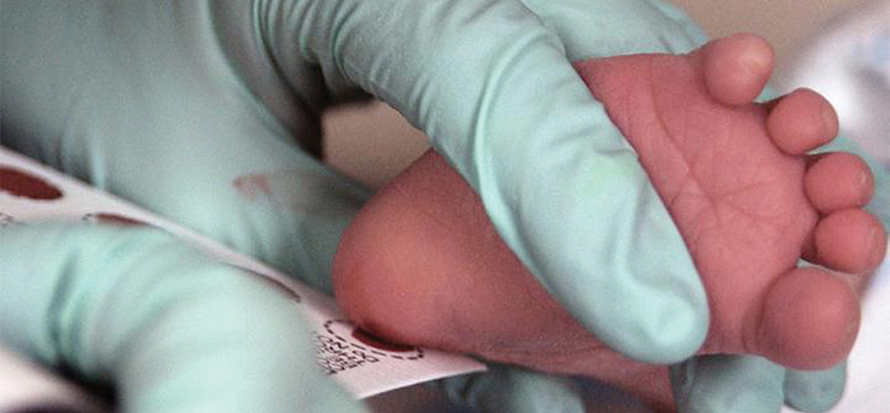A new test for diagnosing
Niemann–Pick disease
Niemann–Pick disease is a rare genetic disease with devastating effects. In one type of the disease, known as type C, defects in lysosomal storage within the cell lead to impaired neurological function. In infants, these symptoms can be especially difficult to recognize. They often include subtle changes in children’s development, such as failure to meet cognitive milestones or poor balance control.
Until recently, the first-line diagnostic test for NPC disease involved a skin biopsy and filipin staining, which is invasive, cumbersome and expensive. Patients with NPC often go up to five years without a diagnosis, drastically limiting the possibility of early interventions.
 A new diagnostic test for Niemann–Pick disease can use previously collected dried blood spots from heel sticks. Courtesy of U.S. Air Force
A new diagnostic test for Niemann–Pick disease can use previously collected dried blood spots from heel sticks. Courtesy of U.S. Air Force
In a paper recently published in the journal Science Translational Medicine, Daniel Ory of Washington University School of Medicine in St. Louis and colleagues lay the groundwork for a promising new diagnostic test for NPC. Importantly, the new noninvasive assay produces results within a day instead of months.
The team used mass spectrometry to analyze dried blood spots collected at various times after birth from patients known to have NPC. They found three bile acid biomarkers that could distinguish NPC patients from people without the disease.
The scientists then determined the structures of the bile acids. Ory and colleagues identified one bile acid as a trihydroxycholanic acid and another as its glycine conjugate.
Since the second bile acid helped the team distinguish NPC patients from non-NPC patients more consistently, the researchers decided to use it to develop a new diagnostic test.
Ory says the assay already is being used at Washington University in St. Louis, Mo., as a diagnostic test. He expects other centers to follow suit.
For its use in newborn screening, Ory says researchers will need to put the assay to the test in the undiagnosed newborn population to ensure its usefulness for that age group. Ory believes the testing process will take several years.
Although the U.S. Food and Drug Administration hasn’t yet approved treatments for NPC, a promising drug called cyclodextrin is moving rapidly through clinical trials. To be effective, treatment interventions will need to take place early in the disease process, which is something the new test could help accomplish. “We’re really trying to make an impact in this NPC community by being able to develop the therapies and being able to diagnose early,” says Ory. The approach “we’ve taken over the last 10 years, I feel like, it’s getting close to bearing fruit.”
Enjoy reading ASBMB Today?
Become a member to receive the print edition four times a year and the digital edition monthly.
Learn moreGet the latest from ASBMB Today
Enter your email address, and we’ll send you a weekly email with recent articles, interviews and more.
Latest in Science
Science highlights or most popular articles

Bacteriophage protein could make queso fresco safer
Researchers characterized the structure and function of PlyP100, a bacteriophage protein that shows promise as a food-safe antimicrobial for preventing Listeria monocytogenes growth in fresh cheeses.

Building the blueprint to block HIV
Wesley Sundquist will present his work on the HIV capsid and revolutionary drug, Lenacapavir, at the ASBMB Annual Meeting, March 7–10, in Maryland.

Gut microbes hijack cancer pathway in high-fat diets
Researchers at the Feinstein Institutes for Medical Research found that a high-fat diet increases ammonia-producing bacteria in the gut microbiome of mice, which in turn disrupts TGF-β signaling and promotes colorectal cancer.

Mapping fentanyl’s cellular footprint
Using a new imaging method, researchers at State University of New York at Buffalo traced fentanyl’s effects inside brain immune cells, revealing how the drug alters lipid droplets, pointing to new paths for addiction diagnostics.

Designing life’s building blocks with AI
Tanja Kortemme, a professor at the University of California, San Francisco, will discuss her research using computational biology to engineer proteins at the 2026 ASBMB Annual Meeting.

Cholesterol as a novel biomarker for Fragile X syndrome
Researchers in Quebec identified lower levels of a brain cholesterol metabolite, 24-hydroxycholesterol, in patients with fragile X syndrome, a finding that could provide a simple blood-based biomarker for understanding and managing the condition.

